and the distribution of digital products.
What Kubernetes Network Plugin Should You Use? A Side by Side Comparison
\ As containerization continues to revolutionize application development, Kubernetes has become the de facto platform for container orchestration. It simplifies deployment and management of applications at scale by providing features such as automatic deployment, scalability, and high availability. The most important component of Kubernetes is its network layer, which provides seamless communication between containers in a cluster. In this article, we will take an in-depth look at four popular Kubernetes networking plugins - Flannel, Cilium, Calico, and Canal. We will look at how each plugin works, evaluate its performance over different protocols, evaluate its security features, and analyze its resource consumption. By the end, you'll have a clearer idea of which plugin might work best for your particular use case.
\
Materials and MethodsFor our comparative analysis, we selected four CNIs (Container Network Interfaces):
- Flannel
- Cilium
- Calico
- Canal (a combination of Flannel and Calico)
We evaluated their performance using benchmarks across several protocols—TCP, UDP, HTTP, FTP, and SCP—on a 10 Gbps network.
\
Test Environment- Hardware: Three Supermicro servers connected via a Supermicro 10 Gbps switch.
- Network Configuration: Direct connections using passive SFP+ DAC cables, configured on the same VLAN with Jumbo frames enabled (MTU 9000).
- Software: Kubernetes 1.14.0 on Ubuntu 18.04 LTS with Docker 18.09.2.
- Setup: The master node was hosted on the first server, the server-side of the tests on the second, and the client-side on the third. We used nodeSelector in Kubernetes deployments to control pod placement.
For clarity and ease of comparison, results are presented in line charts, with "bare metal" performance serving as the baseline.
\
Plugin Descriptions and Working Principles FlannelFlannel is a simple and efficient network solution for Kubernetes, providing connectivity between containers across different nodes in a cluster. It creates an overlay network using the VXLAN protocol, encapsulating and routing network traffic between pods.
\ Key Features:
Assigns a unique IP address to each pod.
Uses a distributed key-value store (etcd or Consul) to maintain network state.
The flanneld agent runs on each node, managing network interfaces and configurations.
\
Working Principle:
When a container starts, it requests an IP from the local flanneld agent, which assigns an IP from Flannel's pool and sets up the necessary virtual interfaces. Traffic between pods on different nodes is routed through the Flannel overlay network using VXLAN encapsulation.
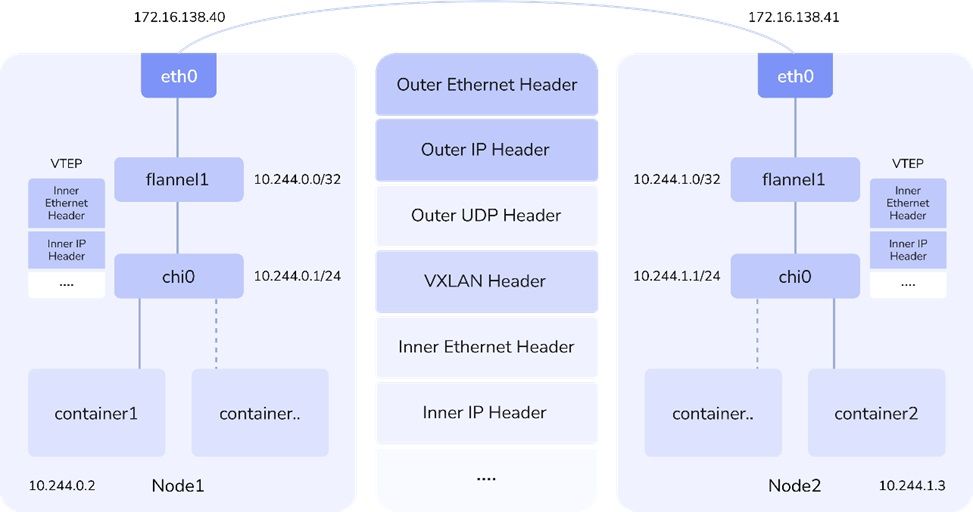
Cilium is a powerful networking and security plugin leveraging eBPF in the Linux kernel for efficient packet processing and policy enforcement. It offers transparent networking and advanced security features, making it suitable for large-scale container deployments.
\ Key Features:
Utilizes eBPF for high-performance networking.
Supports Layer 3/4 and Layer 7 policies.
Integrates with Kubernetes for dynamic service discovery and policy updates.
\
Working Principle:
Cilium uses eBPF programs attached to various hook points in the kernel to monitor and manage network traffic. Policies can be enforced at both network and application layers, providing fine-grained control based on labels and other Kubernetes metadata.
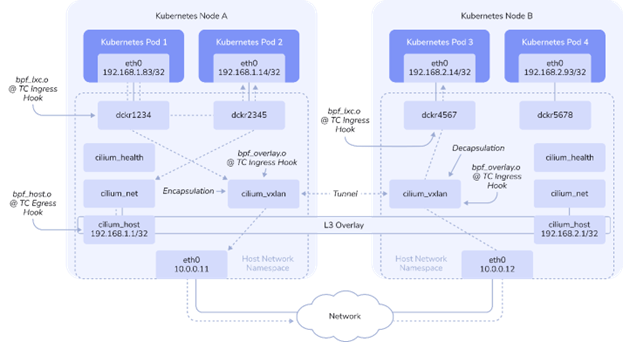
Calico provides networking and security for containerized applications without the overhead of overlay networks, using a pure Layer 3 approach. It leverages BGP for route distribution and offers robust network policy capabilities.
\ Key Features:
Avoids overlay networks for better performance.
Enforces network policies using Kubernetes NetworkPolicy objects.
Supports advanced features like load balancing and traffic shaping.
\
Working Principle:
Calico assigns IP addresses to pods and sets up routes using BGP, allowing direct communication between pods across nodes. Network policies define allowed traffic, enforced by Calico's components running on each node.
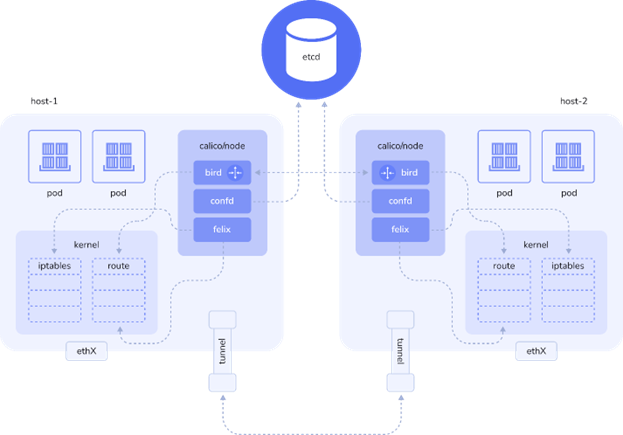
Canal combines Flannel's networking capabilities with Calico's policy enforcement, offering a solution that is both easy to set up and feature-rich.
\ Key Features:
Uses Flannel for the overlay network.
Leverages Calico for network policy enforcement.
Simplifies network setup while providing advanced security
.
Working Principle:
Canal sets up Flannel's overlay network for pod connectivity and uses Calico components to enforce network policies. This hybrid approach allows for straightforward networking with the added benefit of security controls.
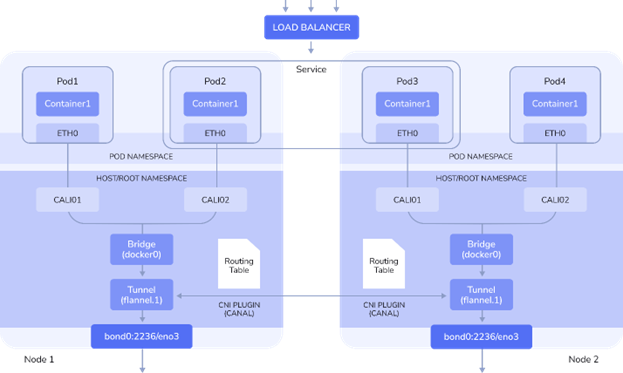
\
MultusMultus is a meta-plugin that enables Kubernetes pods to have multiple network interfaces. It allows integration of multiple CNIs, providing flexibility for complex networking requirements.
\ Key Features:
Supports multiple network interfaces per pod.
Compatible with various CNIs.
Configurable via Kubernetes Network Attachment Definitions.
\
Working Principle:
Multus acts as a CNI plugin that delegates the network attachment process to multiple other CNIs defined per pod. It orchestrates the setup of additional network interfaces based on the pod's annotations and Network Attachment Definitions.
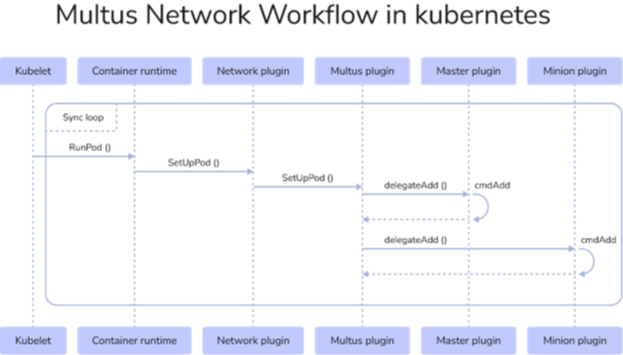
We evaluated the performance of each CNI across different protocols, using "bare metal" performance as a reference. The results are displayed in Mbps.
TCP Protocol Benchmark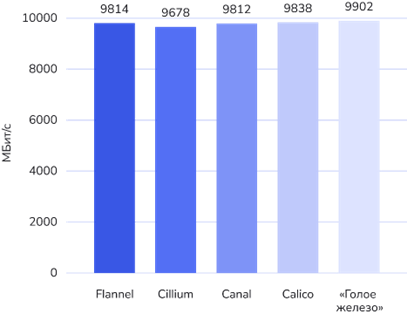
\ \ All CNIs performed similarly over TCP, with Calico slightly outperforming the others. Cilium lagged behind the closest competitor by approximately 134 Mbps.
UDP Protocol Benchmark
\ \ The UDP benchmark mirrors the TCP results, with Calico leading and Cilium trailing. All plugins showed good performance relative to bare metal.
HTTP Protocol Benchmark
\ With HTTP, overall performance decreased slightly. Canal emerged as the leader, with its hybrid nature possibly providing an advantage. Cilium improved to second place, while Calico and Flannel fell behind.
FTP Protocol Benchmark
\ Performance dipped across the board for FTP, with Flannel taking the lead. Cilium's performance decreased significantly in this test.
SCP Protocol Benchmark\
\

\ SCP, utilizing SSH for secure data transfer, resulted in notable performance drops for all setups, including bare metal. All plugins performed similarly, though Flannel had a slight edge.
Resource Consumption and Security Evaluation Security Features- Data Encryption: Among the CNIs tested, only Cilium provides data encryption, utilizing Transport Layer Security (TLS) and mutual TLS (mTLS) for secure communication between microservices.
- Network Policies: All plugins except Flannel support both Ingress and Egress network policies. Flannel lacks built-in network policy support.
We analyzed RAM and CPU consumption for each CNI, including benchmarks without any plugins for reference.
RAM Consumption:
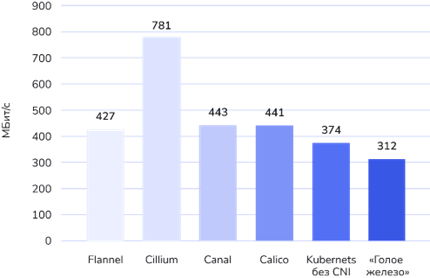
CPU Consumption:
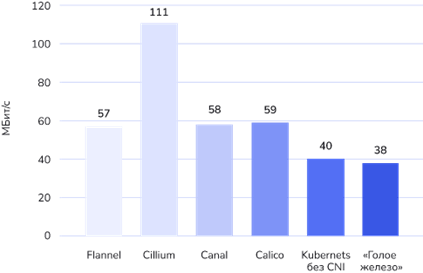
Our benchmarks indicate that Flannel and Calico are among the most performant CNIs.
- Flannel's high performance is likely due to its simplicity and compatibility with various architectures, along with its ability to automatically detect MTU settings.
- Calico offers robust network policy enforcement, making it a strong choice for environments where security is paramount. Its performance, coupled with advanced features like BGP-based routing and policy controls, makes it suitable for complex deployments.
Cilium, while offering advanced security features like data encryption and eBPF-based policy enforcement, showed higher resource consumption and varied performance across protocols. It may be ideal for environments where deep network visibility and security are required, despite the overhead.
Canal provides a balanced approach, combining the strengths of Flannel and Calico. It performed well in certain benchmarks and could be suitable for deployments needing both ease of setup and network policy enforcement.
RecommendationFor environments prioritizing simplicity and resource efficiency: Flannel is an excellent choice.
For environments requiring advanced security and network policies: Calico is recommended.
For high-security environments needing data encryption: Cilium may be appropriate, keeping in mind the higher resource consumption.
For a balanced solution with policy enforcement: Canal offers a middle ground.
\
Note: The figures referenced are illustrative. For actual performance metrics, please refer to the original benchmark data or conduct tests in your own environment.
\ Understanding the specific needs of your Kubernetes deployment is crucial in selecting the right CNI. Factors such as performance, security requirements, and resource availability should guide your decision.
- Home
- About Us
- Write For Us / Submit Content
- Advertising And Affiliates
- Feeds And Syndication
- Contact Us
- Login
- Privacy
All Rights Reserved. Copyright , Central Coast Communications, Inc.